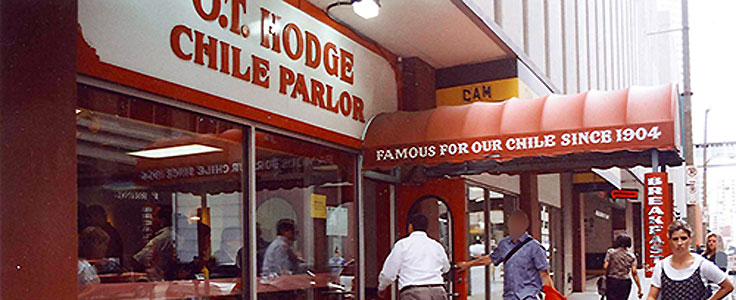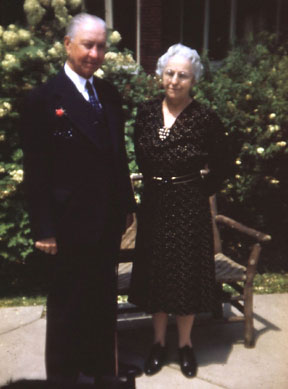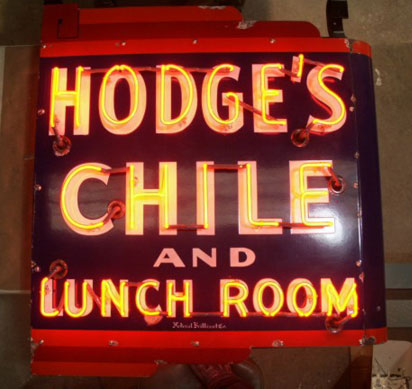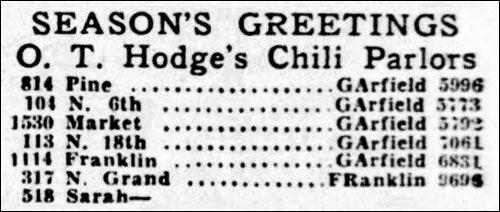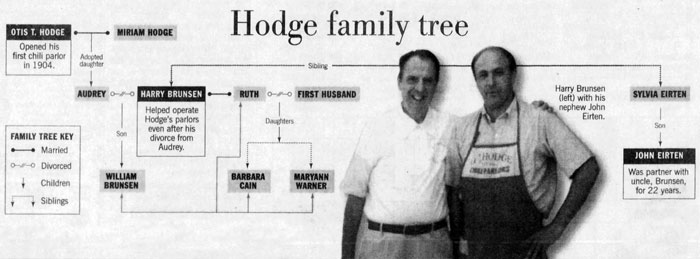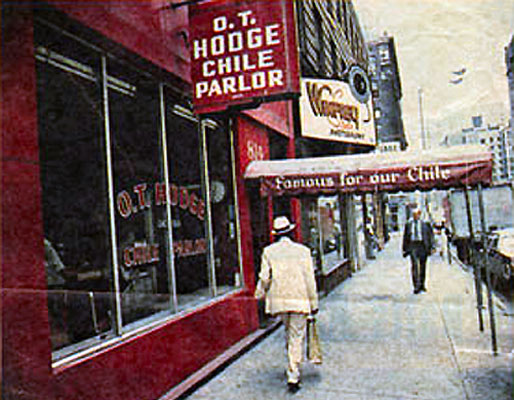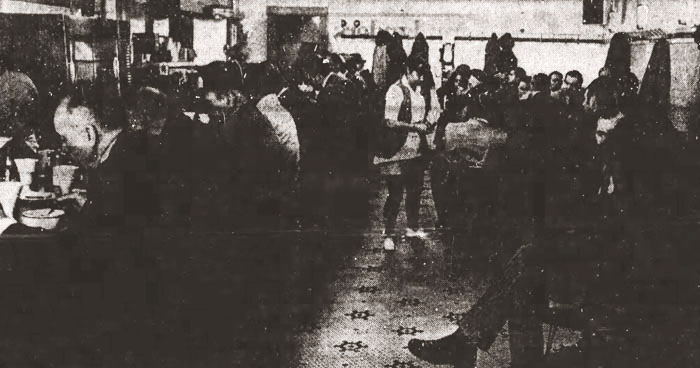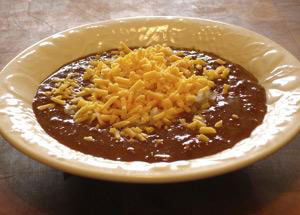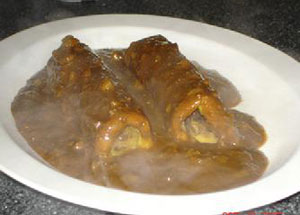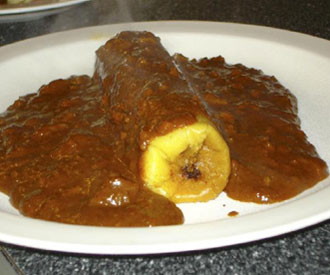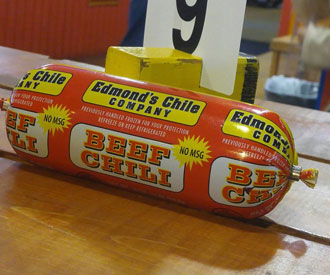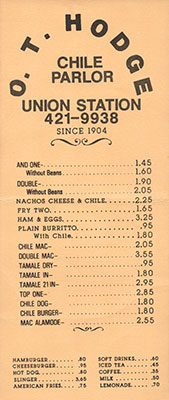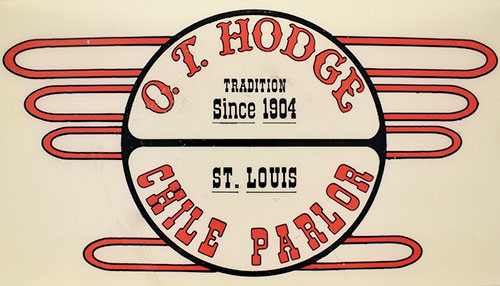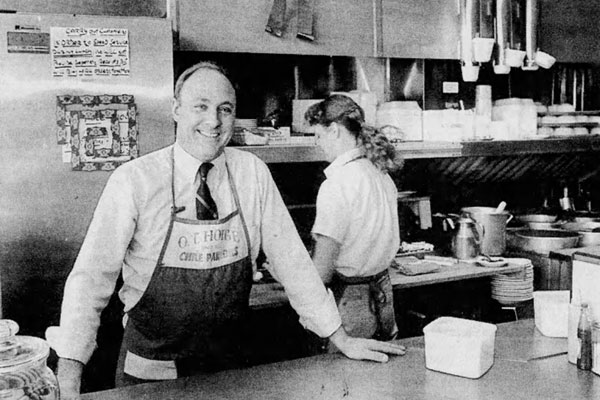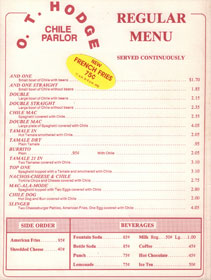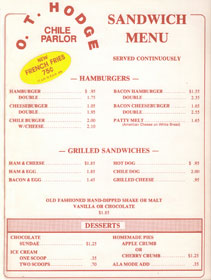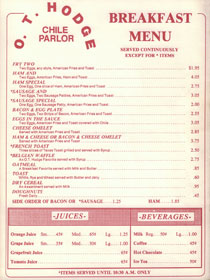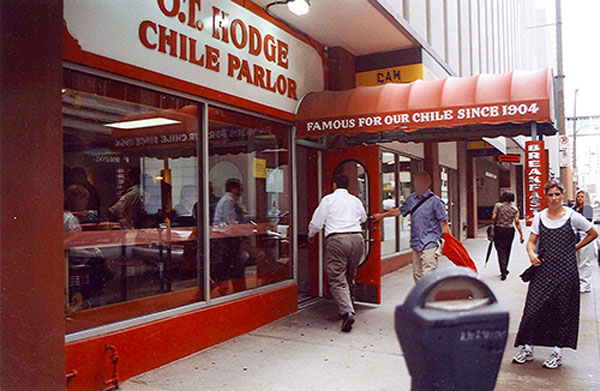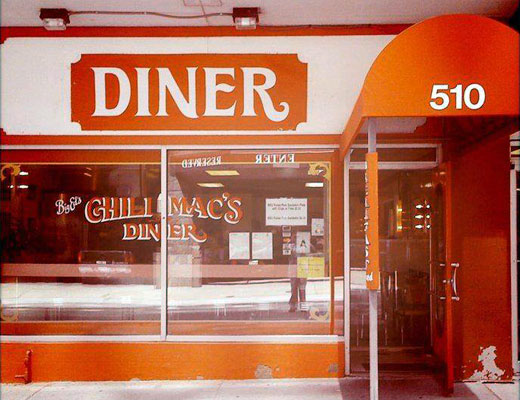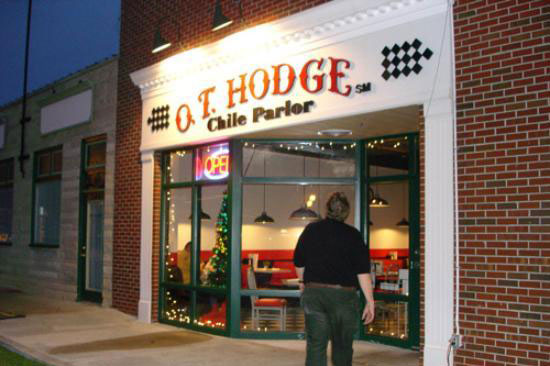|
O. T. Hodge Otis Truman Hodge was born in Perry, Illinois in 1872. By 1880, young Otis had moved with his parents and siblings to Benton Township in Cedar County, Missouri, where his father was a farmer. Hodge had moved to St. Louis by 1900 and set up shop as a barber at 1029 North Broadway. By 1903, he had moved his barbershop to 1003A Pine Street, and he was still cutting hair there when he and his younger brother Mervin set up a food stand at the 1904 St. Louis World's Fair to sell their homemade chili. The chili stand was such a success that O. T. Hodge decided to stop cutting hair and start selling chili full time. Lore has it that Hodge opened his first chili parlor at 814 Pine Street in 1904. However, the 814 Pine location wasn't open until 1917. Hodge opened his first retail chili restaurant at 818 Pine Street, in a space that had formerly housed Mound City Restaurant. He may have opened his restaurant as early as 1905, after the close of the World's Fair. However, Gould's Directory shows Hodge continuing to cut hair at 1003A Pine Street as of 1907 and doesn't list him as a restaurateur at the 818 Pine address until 1908. By 1913, Hodge was selling his chili from a second location at 1611 Market. By 1916, the Market Street address had changed to 1528, and there was a third location at 715 North 6th Street. Hodge's 818 Pine Street restaurant moved two doors down to 814 Pine in 1917, and O. T. Hodge's chili was served at that address until 1985.
Hodge initially christened his restaurant
"Hodge’s Chile and Lunch Room," and the Pine Street location,
with its neon sign, kept the name into the 1940s. However, as Hodge
opened additional locations, he gave them the "O. T. Hodge Chile
Parlor" brand. By 1955, after the exterior of the 814 Pine
restaurant had undergone a major facelift, it too became an O. T.
Hodge Chile Parlor.
In the 1920s, Hodge's chili could be had for 10 cents a bowl, with all meat or with beans added. Chili mac was 15 cents a dish, served with two slices of bread and a pat of butter or with oyster crackers. By 1930, there were seventeen O. T. Hodge Chile Parlors between Jefferson Avenue and the Mississippi River. Hodge ran what was essentially a franchising operation, selling chili to those who’d taken over his parlors. The original chili factory, which was across the street from the Edison Hotel at 18th and Chestnut, used coal-fired chili cookers. Health regulations forced that chili plant to move to a former fire-engine repair station at 2310 Sidney Street. An unidentified photograph of Hodge's 814 Pine Street restaurant, probably taken in the early 1940s, can be found in the Missouri History Museum archives. The Hodge’s Chile and Lunch Room neon sign, with its reflection in the window, is visible in the photo.
Otis T. Hodge died in November of 1942 at the age of 70. By that time, the number of chili parlors bearing his name had been considerably reduced.
* * * * * Harry Brunsen was born in St. Louis and raised in Maplewood. He served in the army in World War II as a baker and cook. After the war, he returned to Maplewood and started the Brunsen Candy Store. Otis and Miriam Hodge had one adopted daughter and no sons. Their daughter, Audrey, married Harry Brunsen, and after Otis Hodge died in 1942, Brunsen took over operation of the chili parlors. Brunsen was married to Hodge’s daughter for 18 years; the couple divorced in 1960. After the divorce, Brunsen stayed in the Hodge family business, running the parlors with his nephew, John Eirten. In 1962, Brunsen married Ruth Brunsen, who was his wife for 36 years.
By 1973, Harry Brunsen's restaurant at 814 Pine Street was the last remaining O. T. Hodge Chile Parlor. Brunson remembered the bustling days when the doors were never locked. "We used to be open all day and all night," he recalled. "Why, sometimes at two or three in the morning there’d be so many winos and, well, other people in here you could hardly sit down." Hodge’s had come a long way from the days when Otis and Miriam Hodge made their chili in a dishpan in the kitchen of the restaurant. But there was still an old world charm about the place. The restaurant had well scrubbed white tiled floor with brown hexagonal patterns. There was a counter and several tables set end to end, communal style. There were wall hooks for hanging coats on three sides of the restaurant. Background music was provided by the crackling sounds of KMOX-FM on a radio that sounded only a tad younger than the restaurant itself.
The restaurant was clean, but not antiseptic. As the waitresses took orders, they deftly placed stainless steel knife, fork and spoon before their customers, and though it seemed they weren't paying attention to what was being said, they heard every word. Part of Hodge’s character stemmed from the manner in which orders were relayed from the waitresses to the kitchen. A large bowl of chili was known as a "double." If beans were to be included, "light" indicated a little and "heavy" a lot. A "double straight" was a large bowl with no beans. An order for two tamales translated into a "twenty-one," while an order of chili mac with tamale became a "mac a la mode."
Hodge’s customers came from nearby Southwestern Bell, the Treasury Department, the Police Department, the Federal Bureau of Investigation, the Mart Building – and throughout the country. "People know us from coast to coast," Brunsen said. "For example, when Buddy Hackett was here he ate here almost every day. And so did John Banner when he was appearing at the American Theater." (Banner played Sergeant Schultz in the television series Hogan’s Heroes.) The chili recipe used was the original one, and it was stored in a safety deposit box. A separate firm under a different name – Edmond’s– had been established to place the chili on the retail market. Sold in rolls which had to be mixed with equal parts water, the chili was the same that was served at the Pine Street restaurant.
The chili was stored in vats in refrigerated rooms in the basement of the restaurant. In an average day, customers went through 20 containers of chili; each container held 45 pounds of chili. Three containers were kept going on the steam table, along with a container of beans. Dried pinto beans were used because they cooked up firm and had better flavor. "Oddly enough," Brunsen observed, "January, February and March are our worst months – that’s when you’d think chili would be most popular. Our best months are May and June." Brunsen thought that was because there were more people out and about downtown in the summer months. "Although it’s hard to tell, really," he continued, "so much has changed over the years." He remembered 1956 as a peak year, but said that things had been going down since then. The second oldest parlor, at 104 North Sixth Street, became history when the site was snapped up for a parking garage. It had been there for over 50 years. "I suppose I could pick up and move to the county like a lot of other businesses have done, but it just wouldn’t be the same," Brunsen said. * * * * * The O. T. Hodge Chile Parlor at 814 Pine Street closed in August of 1985; Hodge's chili had been served on the block for 80 years. However, shortly thereafter, an O. T. Hodge Chile Parlor opened in the newly renovated Union Station. Another was opened by the beginning of 1987 in the new downtown Union Market, and by the end of 1988, there were new chili parlors at 611 Pine and 1622 South Jefferson in Lafayette Square. O. T. Hodge’s most famous dish was the "slinger" – two cheeseburgers, a pair of fried eggs and American fries or hash browns, blanketed with chili and sometimes red peppers. St. Louis Post-Dispatch
food critic Joe Pollack wrote in a July 10, 1995 column:
"I’ve never seen slingers served anywhere but Hodge, and
they’re perfect at 3 in the morning, after the saloons
close, when the body is in great need of sustenance for the
journey home. At lunch, they’re a little frightening,
especially when you’re at the counter and watch the
preparation."
By 1995, there was an O. T. Hodge Chile Parlor at 510 Pine Street. If you sat at the counter, one of Hodge's beloved gruff waitresses would take your order over your shoulder. She usually served you that way, although sometimes a cook would hand you your "and one" – the Hodgeian tongue for a bowl of chili with beans.
Harry Brunsen died in
October of 1998 at the age of 80. Brunsen retired in the
early 1990s, but had continued to be active at the chili
parlors almost daily. John Eirten continued to operate three
of the five remaining parlors – on North Broadway, Pine
Street and Jefferson Avenue. The other two, one at Union
Station and the other in Crestwood, were franchised. The legal battle ended in 2003 with the Brunsen family owning the name and obtaining sole right to the manufacturing and sale of the chili formula. The family sold its stock in the restaurants to John Eirten, allowing each side to go their own way. Eirten changed the name of the three Hodge parlors he owned – at 3523 North Broadway, 6 South Central in Clayton and 510 Pine Street – to Big Ed’s Chili Mac’s.
The Brunsen family attempted to license additional O. T. Hodge Chile Parlors. Only two were left at the time of the settlement, one on South Jefferson and one on Watson Road in Crestwood, and they closed shortly thereafter. In 2005, one last O. T. Hodge Chile Parlor was licensed at 250 South Florissant Road in Ferguson. It served "double straights" and "slingers" until it closed in 2008.
Copyright © 2023 LostTables.com |

